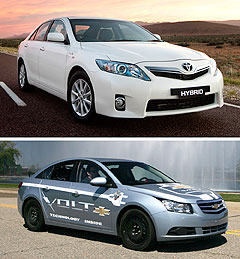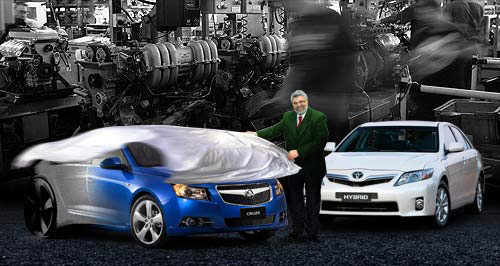News - General NewsMore local hybrids, EVs in pipelineMore to come: Industry minister Kim Carr predicts the Australian car industry will unveil more hybrids and EVs. Digital image Kim Carr sees new Australian-built hybrids, EVs on sale inside five years10 Aug 2010 By TERRY MARTIN FEDERAL industry minister Kim Carr believes Australian-produced hybrid and electric vehicles will broaden beyond the Toyota Camry Hybrid within five years, and has vowed that the government, if returned to office, would invest heavily in building local capacity in EV and related technologies. In an interview with GoAuto, Senator Carr, who is also the innovation, science and research minister, refused to commit to EV or low-carbon-car subsidies, arguing that such incentives would support overseas car industries to the detriment of Australian industry. Instead, the minister said the Labor government’s focus remained on investing in specific programs in partnership with local car-makers, component suppliers, science bodies such as the CSIRO, and other organisations, with several significant new green car-related projects in the pipeline. He said the government had also relaxed the requirement for companies applying for a slice of the $1.3 billion Green Car Innovation Fund to provide 75 per cent of program investment (with taxpayers tipping in one dollar for every three private dollars in a project), revealing there was now flexibility in the guidelines. When asked if the government had any indication of projects, other than the Camry, to build hybrid or electric vehicles in Australia, Senator Carr said: “Yes, we have. “There are new projects in the pipeline from the MVPs (motor vehicle producers) and the CSIRO and other options that are being investigated right now. I’m not at liberty to discuss those because they are commercial-in-confidence, but you shouldn’t assume that this (Camry) is the only project that is on the go.” Asked if he could see locally produced hybrid or electric cars on Australian roads in the next five years, Senator Carr also said: “Yes. I do. “I think there will be more diversification in regard to development of electric capacity. But it’s not just electric capacity. I’m saying that fuel systems are also an alternative that should not be discounted. And that includes LPG and CNG, as well as petrol.”  Left: Camry Hybrid. Below: Chevrolet Cruze plug-in hybrid mule. Left: Camry Hybrid. Below: Chevrolet Cruze plug-in hybrid mule.One of the likely big-ticket green cars in future years is the Holden-built Cruze small car, which enters production in conventional-engine form early next year but was described at its program announcement as a vehicle that could offer hybrid, LPG, CNG and E85 ethanol capability. GM has since shown a Cruze prototype in the US with running gear from the Volt hybrid, while the latter is based on the same platform as the Cruze and – like a plug-in Cruze – could potentially be built here after being launched as an import from 2012. Senator Carr, who specifically referred to the Cruze when asked about future Australian-built cars using alternative powertrains, said: “Our task is to develop the investment, or the business case for new investment, for new models – to strengthen those capabilities – and I’m confident we can do that. “But you’ll only do it if the New Car Plan is able to be put into place. You’ll only do it if you have a government that is committed to the future of the industry. You’ll only do it with a government that is prepared to work in partnership with the industry to ensure that both workers and managers know they have a secure future. And the key to our success is attracting that new investment.” Senator Carr said he was certain that Australia would still have three manufacturers – Ford, Holden and Toyota – building cars in this country in 2020, although he could not specifically say that this would include engine production. As GoAuto has reported, Toyota Australia is negotiating with Japan over engine production at its Altona plant in Victoria beyond the current-generation Camry/Aurion, while the future of Ford’s Geelong engine plant is also uncertain beyond the current Falcon and Territory. “I’m confident in the future of the three manufacturers being maintained here, in the full range – the full range – of capabilities, from design and engineering through to manufacturing,” Senator Carr told GoAuto. “I say to you, the (Geelong) engine plant is working well. We are working with Ford to develop new markets for that plant, and we are working with Ford to make sure that it increasingly meets the international standards in terms of tailpipe requirements. “I am very confident in the strength of our relationship and I have every cause for confidence about the future of the industry at our three motor vehicle manufacturers.” Senator Carr said a key to this was strengthening Australia’s supply chain – “the 200 companies that make up the industry, not just the three (car-makers)” – and that the highest priority area under the so-called Automotive Australia 2020 roadmap released last week was vehicle electrification, including hybrid and electric vehicles. Despite other countries being targeted as EV hubs – particularly China, which GM, for one, last month identified as the future home of an all-new global EV and green tech centre – a Gillard government, and indeed a Carr-led federal automotive ministry, will work to build capacity in the same area. “With electrification, in terms of supercapacitors, in terms of the electric vehicle power modules, battery technology, electric motors and generators, the various elements of the powertrain for electric motors – these are capacities that we’ve got to put a lot more energy into,” he said. “But we can’t predetermine an outcome because we can’t say in advance what are the areas that are going to be commercially viable. We’ve got to develop capacity – that’s why we ask people to put their own money in we co-invest – but we don’t try to predetermine where these technologies will take us.” Senator Carr also said that the conventional internal combustion engine “has still got a long way to run in Australia” and highlighted other key planks of the new roadmap – which will draw its funds from the existing $6.2 billion New Car Plan for a Greener Future – including gaseous fuels, light weight technology and data communications. “Existing vehicle technologies – we can squeeze a lot more out of it in terms of fuel efficiency and greenhouse gas reductions,” he said. “That’s why we’ve got electrification as one stream, (but) we’ve also got new fuel systems and light weighting as another, and IT, as being a very important part of driving future industry directions. “At the end of the day, our whole program is geared toward co-investment. It’s about attracting new investment that transforms the industry.” This unapologetic support for the local industry has seen Senator Carr reject warnings from car companies and representative bodies that Australia is being left behind on the electric car – and low-emissions-car – front. He refuses to accede that the government should follow other countries in providing subsidies that attract more electric car imports, despite obvious potential environmental benefits. “People are jumping the gun on all of that,” Senator Carr said. “It’s not been our intention to provide the subsidies that some of the importers want. We are committed to domestic manufacture. We see as our priority for the program as building capability in Australia. “One of the serious problems at the moment with electric vehicles that are being imported is their cost, and there is this expectation that there should be some sort of subsidy to reduce the cost. Well, we say that we can actually build capacity in Australia rather than develop the capacities of other people’s automotive industry.”  Read more10th of August 2010  Coalition will ‘kill’ Carr-led plansAn Abbott government would ‘kill or cripple’ Labor’s innovation policies: Carr10th of August 2010  Eco battery gets jump start from CanberraBig grant for Century Yuasa battery project as Carr defends green car fund3rd of August 2010  Rumblings on ‘clunkers’ moveMany in auto industry question effectiveness of $2000 bounty on old trade-ins27th of July 2010  Gillard promises cash for clunkers$394 million pledged to rid Aussie roads of inefficient pre-1995 cars27th of July 2010  Gillard commits to fuel consumption standards by 2015Australia to follow US and Europe with CO2 emissions standards under Gillard policy |
Click to shareGeneral News articlesResearch General News Motor industry news |
















Facebook Twitter Instagram